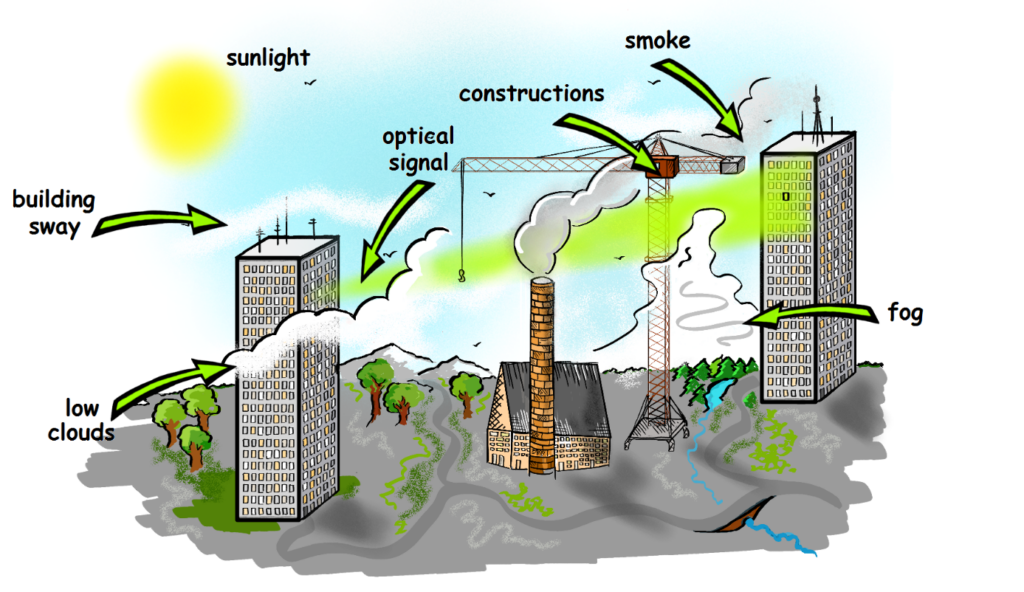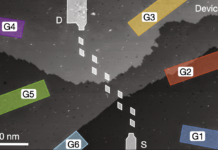One of the biggest technological problems in the modern world is limited access to the Internet. Despite the wide application of fiber-optic links, this solution can not be used everywhere. It is challenging in dense urban areas and even impossible in some places, especially over roads, water reservoirs, or particular architectural areas like historic city districts.
In addition to cable communication, microwave links based on high-frequency beams of radio waves were very popular in the last century. Such technology offers a high capacity for transferred data; however, installing microwave links becomes difficult due to the saturation of radio frequencies in large cities.
Considering factors such as sensitivity to interferences, increased risk of confidential data leakage, concerns about adverse health effects, and high license fees, the search for alternative solutions began. Here emerged the Optical Wireless Links or Free-Space Optics communication systems offer fewer inconveniences than microwave links.
Free-Space Optics communication is a laser-based technology that allows us to provide Internet access in places where it was impossible before. It also makes it possible to quickly rebuild communications systems damaged due to natural disasters like floods, fires, or a tornado. It offers long-distance data transmission, even up to 8 kilometers, with a high capacity reaching up to Terabits per second.
Currently, it is hard to imagine an efficient and fast flow of information without Free-Space Optical technology, which uses light propagating in the air, outer space, and the vacuum. However, the efficiency of information transmission depends on the medium in which it occurs. The factors like rain, fog, haze, physical obstruction, interaction with atoms and molecules, and atmospheric turbulence degrade its performance.
How does this technology make life easier for us every day? To understand how it is possible and improve it, we must first understand the atmosphere and light propagation.
Free-space optics communication vs. atmosphere
Free-Space Optics is based on the transmission of light between two points: a source and a detector.
As the fiber optic, Free-Space Optics uses an infrared laser; however, the information flies in the air instead of using a glass fiber cable. It may sound simple, but it is highly dependent on atmospheric conditions like air turbulence.
Free-Space Optics links transmit data as far as 8 kilometers with a high capacity reaching 100 Gigabits per second at frequencies above 300 GigaHertz. Every obstacle like gases present in the atmosphere standing in the way of the transmitted light causes the decrease of the signal getting to the detector.
The atmosphere’s primary role is protecting living organisms from dangerous ultraviolet (UV) rays from the Sun. It allows life to exist on Earth. It is made of nitrogen (78%), oxygen (21%), and about 1% of other gases like argon, carbon dioxide, helium, and others. It also contains aerosols, which are tiny objects dispersed in the air like a sea breeze, fog; or tiny particles like dust from the desert or volcano, smoke from a fire, or even frozen water particles. The concentration of aerosols in the atmosphere changes depending on the geographical location and human activity.
How does the air affect the optical signals?
Light is composed of subatomic particles called photons. When photons cross the atmosphere to reach the Earth’s surface, the presence of vaporized aerosols in the air —their type, size, and concentration— affects their travel.
For example, in a marine climate, aerosols are formed mainly by salty water droplets like fog, foam, drizzle, or rain. In urban areas, aerosols’ primary source is industrial activity, and they have different chemical compositions. When the light passes through the atmosphere, every single photon is like a super-fast solid riding a very crowded highway. What photons find in their way influences the efficiency of the light transferred in the communication technology.
Imagine that you stand on the top of a mountain and turn on a flashlight. On another mountain, there is a detector that measures the light intensity of your source. The farther the detector is, the less light intensity is transmitted. And, of course, light propagation paths must be free of large objects like trees or building constructions.
The idea of the Free-Space Optics technology
In contrast to the white light from the Sun, which has all colors of the rainbow, the light from a laser has only one color. Besides, the photons from a laser beam go in a specific direction; It does not flash in every direction, like a lightbulb.
When a laser beam goes through the air containing various aerosols, it can be dispersed and therefore spotted in a different place as expected. Fluctuations of the air caused by the wind and heat influence the laser beam pathway, changing its intensity and the spot’s size. This interaction of the laser beam with matter results in loss of optical signal power, affecting data transmission quality.

Despite all these laser-outdoors interaction problems, this technology is faster than fiber optics since light travels faster in the atmosphere than in glass. It is unaffected by radio interference and can be deployed behind windows, eliminating multiple problems associated with using rooftops, such as legal costs and maintenance of the equipment.
Companies should design Free-Space Optics links to maintain a compromise between good range and the eye safety of bystanders. The sources and receivers are often installed on the top of tall buildings to avoid accidents with people’s appearance in the beam path, which may block the signal and be exposed to eye damage. Besides, installations on high palaces are challenging to eavesdrop on, maintaining a good level of transmitted data security.
Applications
Free-Space Optics has many applications in communication between buildings, ships, satellites to ground, aircraft, and the military. Thanks to that technology, we can send cross-continental messages within just a few seconds. We use this method of communication daily when shopping with a smartphone, consulting a doctor, or taking part in distance learning.
The fast development of various regions requires fast solutions in data transmission and moves forward optics instead of cable communication. Free-Space Optics technology offers flexibility, low costs of the link installation, huge capacity, and wide bandwidth. Its infrastructure must adjust to the fifth-generation (5G) and the sixth-generation (6G) standards in the first step. The next step in developing this technology is the long-range or Deep-Space Optical Communications, which brings links outside the Moon’s orbit space. NASA also leads the communication project called Deep-Space Optical Terminals to develop a tool that allows live High Definition video, telepresence, and human space exploration.
This article is a joint work of Magdalena Garlińska (National Center for Research and Development, Poland), Agnieszka Pregowska (Institute of Fundamental Technological Research, Polish Academy of Sciences, Poland), and Magdalena Osial (Faculty of Chemistry, University of Warsaw, Poland) as a part of the Science Embassy project. Image credit – Magdalena Osial.
References
- Garlinska M., Pregowska A., Masztalerz K., Osial M. (2020). From mirrors to free-space optical communication-historical aspects in data transmission, Future Internet 12, 11, 179–1–18.
- Barry R. G., Chorley R. J. (1971). Atmosphere, Weather, and Climate. London: Methuen & Co Ltd.
- Bouchet O., Sizun H., Boisrobert C., Fornel F., Favennec P. (2006). Free-Space Optics Propagation and Communication. ISTE Ltd.
- Andrews L. C. (2004). Field Guide to Atmospheric Optics. SPIE Press.
- Deutsch L., Lichten S. M., Hoppe D. J., Russo A. J., Cornwell D. M. (2019). Creating a NASA Deep Space Optical Communications System. In Space Operations: Inspiring Humankind’s Future; Pasquier, H., Cruzen, C., Schmidhuber, M., Lee, Y., Eds.; Springer: Cham, Switzerland, 43–62.
- Nadi M., Rajabalipanah H., Cheldavi A. Abdolali A. (2020). Flexible Manipulation of Emitting Beams Using Single-Aperture Circularly Polarized Digital Metasurface Antennas: Multi-Beam Radiation toward Vortex-Beam Generation. Adv. Theory Simul 3, 1900225.
- Viswanathan H., Mogensen P. E. (2020). Communications in the 6G Era. IEEE Access 8, 57063–57074.
- Raj A. B., Majumder A. K. (2019). Historical perspective of free-space optical communications: From the early dates to today’s developments. IET Commun. 13, 2405–2419.
- Alimi I. A., Muga N. J. (2020). Simple and robust transmit diversity-based free-space optical communications for 5G and beyond networks. Opt. Commun. 476, 126306.
- STMD: Game-Changing Development. NASA. Available online: gameon.nasa.gov/archived-projects-2/deep-space-optical-communications-dsoc/ (accessed on 26 May 2021).




